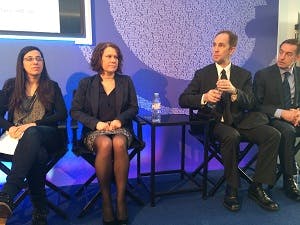Newsroom
Content Piracy a Hot Topic at Advertising Week Europe #AWEurope
Content piracy was a featured topic at Advertising Week Europe this week. With the IAB UK moderating a panel, DV participated in the discussion along with the City of London’s Police Intellectual Property Crime Unit (PIPCU), the Federation Against Copyright Theft (FACT), Ender Analysis and Improve Digital to unravel this topic, share the ongoing efforts the entire industry is doing to combat this situation and what the role of advertising plays in this arena.

Some key facts shared by Ender Analysis:
- Consumption of digital media (music, movies) is increasing in the UK
- 20% of all illegal downloads worldwide are from British Artists
- UK consumers spend more time online than their Australian and US counterparts’
With the proliferation of copyrighted content accessibility, the City of London Police and FACT have been steadfast and diligent in their efforts to protect content owners from this practice by creating the Infringing Website List (IWL) and in working with companies like DV to block ads from appearing on those sites. Creating and maintaining lists that identify these content piracy sites is extremely important but only solves half the problem. Strong technology needs to be implemented in order to uncover the instances of fraud like “bait and switch” to fully prevent this from affecting advertisers.
What we have found at DV, sites that cannot legitimately monetise impressions but tend to garner real human traffic (such as these content piracy sites) often look for ways to gain revenue through fraudulent practices like:
- Hidden ads: Copyright infringement sites sometimes hide ads in portions of their backend code which is not able to be seen by end users, making it difficult to detect from simply reviewing the site content (yet advertisers are still paying for those impressions). This tactic is aimed at CPM buys.
- Hidden ads with a graphic: Copyright infringement sites sometimes hide ads by placing another graphic on top (download now button) that would encourage a user to click on it. This tactic is aimed at CPC buys.
- Impression Laundering: Copyright infringement sites spoof the online buying ecosystem but submitting fake URLs to gain ad buys but launder the ads to their sites with users (as seen in the DV Fraud Lab Report). This “Bait and Switch” model where both sites are owned/operated by the copyright infringement site owner.
Content piracy does not just affect content owners, but also it impacts advertisers, publishers and consumers in the following ways:
- Damage to Advertisers: loss of money, no value impressions, brand reputation, and more
- Damage to Publishers: devaluing of ad inventory (high supply of 'bad inventory' reduces cost for good inventory)
- Damage to Consumers: in most instances, those that are monetising copyright infringement sites are also infecting malware (bots) into the ecosystem on those users accessing the content
When combating content piracy, solutions as robust as those fighting against ad fraud are needed to fully eradicate the issue.